Organizational Structure and Design Analysis: Samsung Case Study
VerifiedAdded on 2023/01/06
|10
|3117
|81
Report
AI Summary
This report provides a comprehensive analysis of Samsung's organizational structure and design, focusing on the factors that influence its operations. It examines the impact of the company's size, global presence, and technological advancements on its structure. The report also explores the importance of skilled manpower and how Samsung manages its dynamic processes to maintain a competitive edge. Key aspects discussed include the company's product type divisional structure, the role of technology in driving innovation, and the significance of corporate culture in fostering collaboration and ethical practices. The report highlights how Samsung adapts to changes, promotes innovation, and motivates its employees to achieve its strategic objectives in the electronics and semiconductors industries. Furthermore, it emphasizes the influence of organizational culture on human resource management and decision-making within the company.
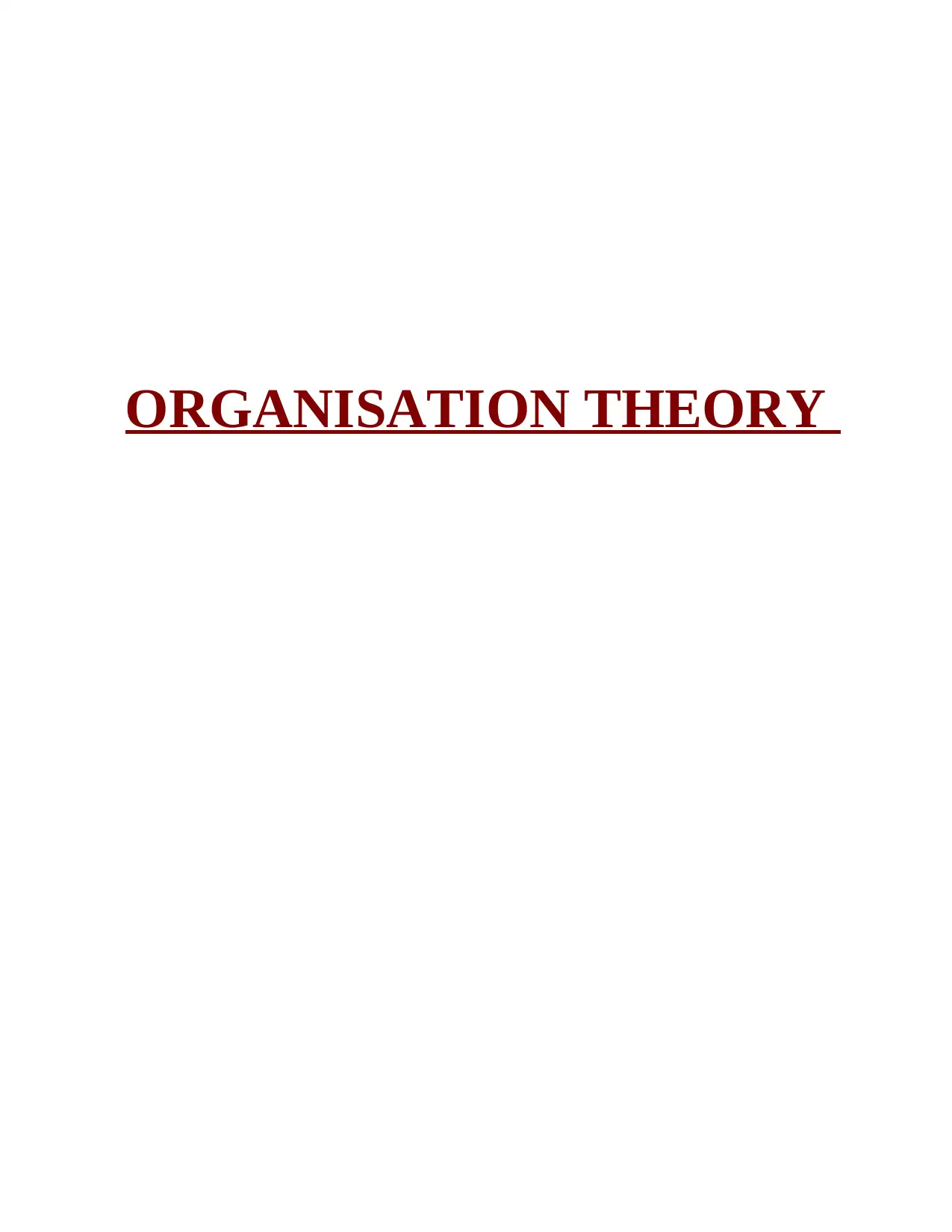
ORGANISATION THEORY
Paraphrase This Document
Need a fresh take? Get an instant paraphrase of this document with our AI Paraphraser
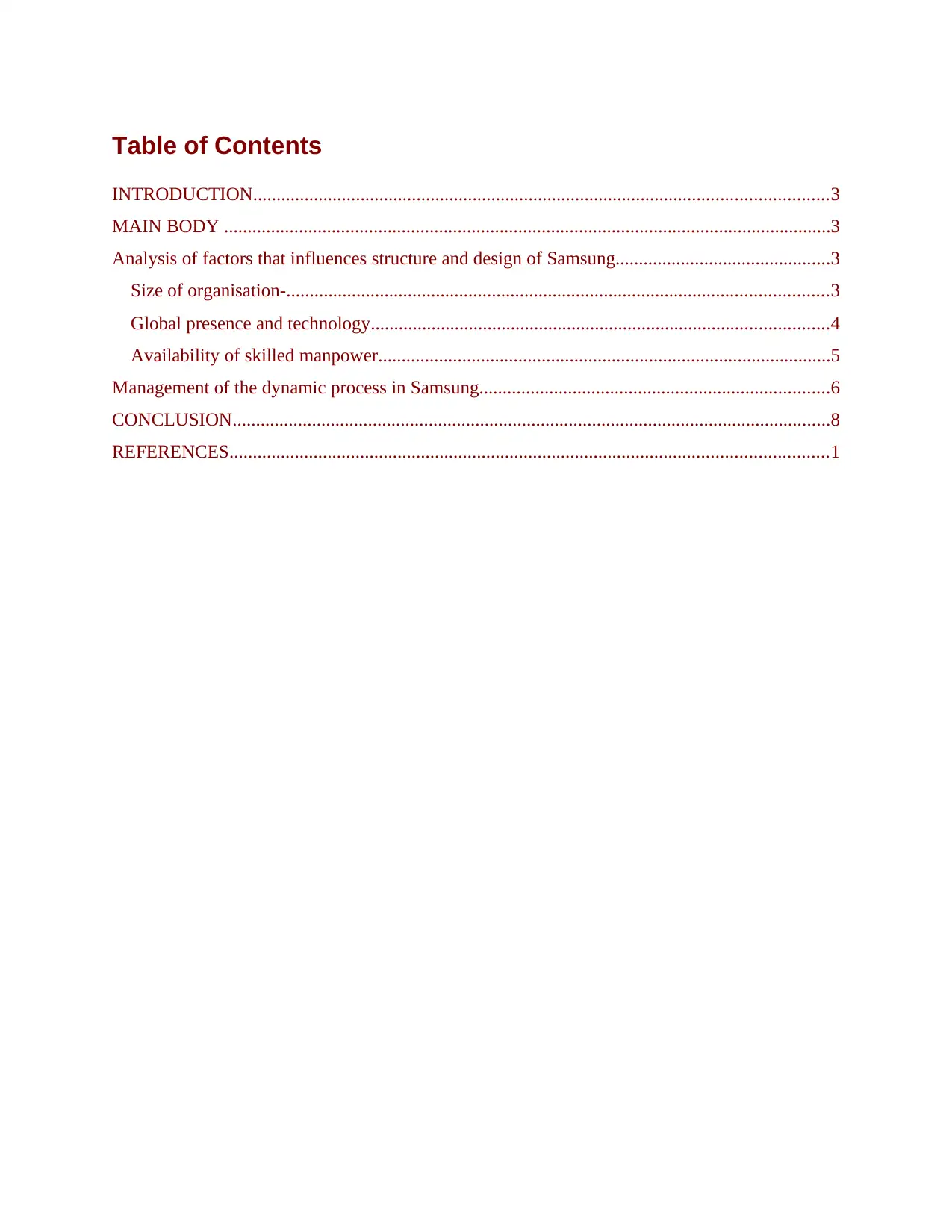
Table of Contents
INTRODUCTION...........................................................................................................................3
MAIN BODY ..................................................................................................................................3
Analysis of factors that influences structure and design of Samsung..............................................3
Size of organisation-....................................................................................................................3
Global presence and technology..................................................................................................4
Availability of skilled manpower.................................................................................................5
Management of the dynamic process in Samsung...........................................................................6
CONCLUSION................................................................................................................................8
REFERENCES................................................................................................................................1
INTRODUCTION...........................................................................................................................3
MAIN BODY ..................................................................................................................................3
Analysis of factors that influences structure and design of Samsung..............................................3
Size of organisation-....................................................................................................................3
Global presence and technology..................................................................................................4
Availability of skilled manpower.................................................................................................5
Management of the dynamic process in Samsung...........................................................................6
CONCLUSION................................................................................................................................8
REFERENCES................................................................................................................................1
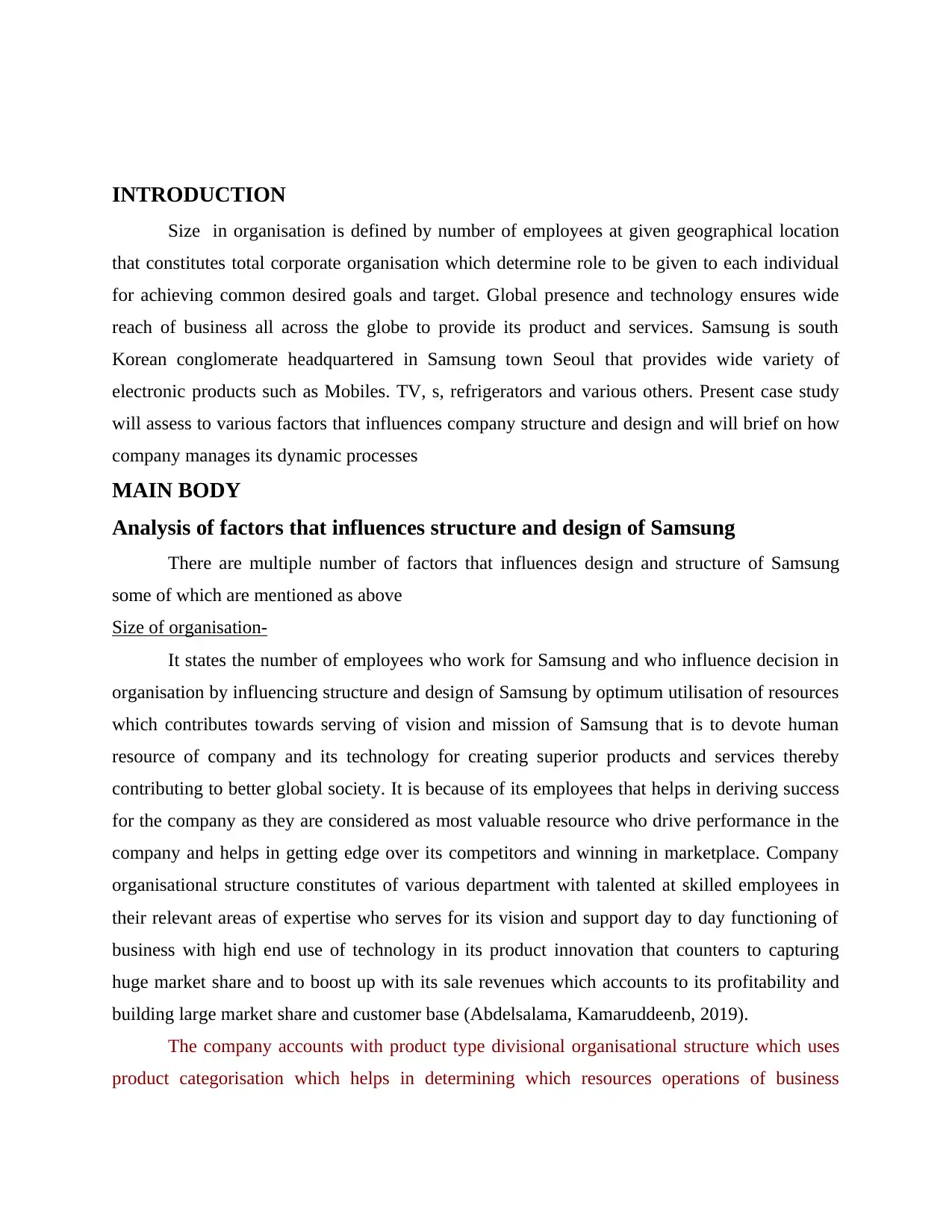
INTRODUCTION
Size in organisation is defined by number of employees at given geographical location
that constitutes total corporate organisation which determine role to be given to each individual
for achieving common desired goals and target. Global presence and technology ensures wide
reach of business all across the globe to provide its product and services. Samsung is south
Korean conglomerate headquartered in Samsung town Seoul that provides wide variety of
electronic products such as Mobiles. TV, s, refrigerators and various others. Present case study
will assess to various factors that influences company structure and design and will brief on how
company manages its dynamic processes
MAIN BODY
Analysis of factors that influences structure and design of Samsung
There are multiple number of factors that influences design and structure of Samsung
some of which are mentioned as above
Size of organisation-
It states the number of employees who work for Samsung and who influence decision in
organisation by influencing structure and design of Samsung by optimum utilisation of resources
which contributes towards serving of vision and mission of Samsung that is to devote human
resource of company and its technology for creating superior products and services thereby
contributing to better global society. It is because of its employees that helps in deriving success
for the company as they are considered as most valuable resource who drive performance in the
company and helps in getting edge over its competitors and winning in marketplace. Company
organisational structure constitutes of various department with talented at skilled employees in
their relevant areas of expertise who serves for its vision and support day to day functioning of
business with high end use of technology in its product innovation that counters to capturing
huge market share and to boost up with its sale revenues which accounts to its profitability and
building large market share and customer base (Abdelsalama, Kamaruddeenb, 2019).
The company accounts with product type divisional organisational structure which uses
product categorisation which helps in determining which resources operations of business
Size in organisation is defined by number of employees at given geographical location
that constitutes total corporate organisation which determine role to be given to each individual
for achieving common desired goals and target. Global presence and technology ensures wide
reach of business all across the globe to provide its product and services. Samsung is south
Korean conglomerate headquartered in Samsung town Seoul that provides wide variety of
electronic products such as Mobiles. TV, s, refrigerators and various others. Present case study
will assess to various factors that influences company structure and design and will brief on how
company manages its dynamic processes
MAIN BODY
Analysis of factors that influences structure and design of Samsung
There are multiple number of factors that influences design and structure of Samsung
some of which are mentioned as above
Size of organisation-
It states the number of employees who work for Samsung and who influence decision in
organisation by influencing structure and design of Samsung by optimum utilisation of resources
which contributes towards serving of vision and mission of Samsung that is to devote human
resource of company and its technology for creating superior products and services thereby
contributing to better global society. It is because of its employees that helps in deriving success
for the company as they are considered as most valuable resource who drive performance in the
company and helps in getting edge over its competitors and winning in marketplace. Company
organisational structure constitutes of various department with talented at skilled employees in
their relevant areas of expertise who serves for its vision and support day to day functioning of
business with high end use of technology in its product innovation that counters to capturing
huge market share and to boost up with its sale revenues which accounts to its profitability and
building large market share and customer base (Abdelsalama, Kamaruddeenb, 2019).
The company accounts with product type divisional organisational structure which uses
product categorisation which helps in determining which resources operations of business
⊘ This is a preview!⊘
Do you want full access?
Subscribe today to unlock all pages.

Trusted by 1+ million students worldwide
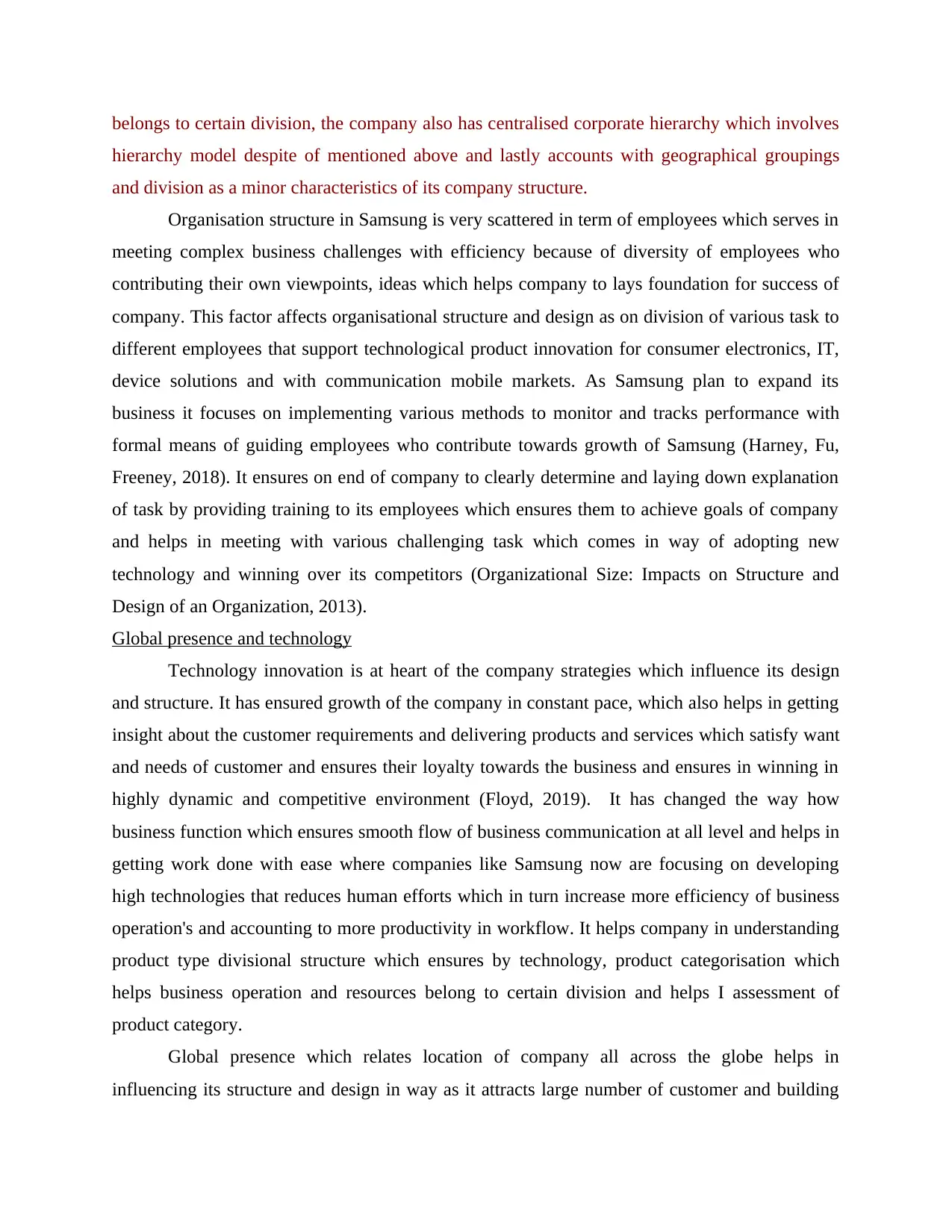
belongs to certain division, the company also has centralised corporate hierarchy which involves
hierarchy model despite of mentioned above and lastly accounts with geographical groupings
and division as a minor characteristics of its company structure.
Organisation structure in Samsung is very scattered in term of employees which serves in
meeting complex business challenges with efficiency because of diversity of employees who
contributing their own viewpoints, ideas which helps company to lays foundation for success of
company. This factor affects organisational structure and design as on division of various task to
different employees that support technological product innovation for consumer electronics, IT,
device solutions and with communication mobile markets. As Samsung plan to expand its
business it focuses on implementing various methods to monitor and tracks performance with
formal means of guiding employees who contribute towards growth of Samsung (Harney, Fu,
Freeney, 2018). It ensures on end of company to clearly determine and laying down explanation
of task by providing training to its employees which ensures them to achieve goals of company
and helps in meeting with various challenging task which comes in way of adopting new
technology and winning over its competitors (Organizational Size: Impacts on Structure and
Design of an Organization, 2013).
Global presence and technology
Technology innovation is at heart of the company strategies which influence its design
and structure. It has ensured growth of the company in constant pace, which also helps in getting
insight about the customer requirements and delivering products and services which satisfy want
and needs of customer and ensures their loyalty towards the business and ensures in winning in
highly dynamic and competitive environment (Floyd, 2019). It has changed the way how
business function which ensures smooth flow of business communication at all level and helps in
getting work done with ease where companies like Samsung now are focusing on developing
high technologies that reduces human efforts which in turn increase more efficiency of business
operation's and accounting to more productivity in workflow. It helps company in understanding
product type divisional structure which ensures by technology, product categorisation which
helps business operation and resources belong to certain division and helps I assessment of
product category.
Global presence which relates location of company all across the globe helps in
influencing its structure and design in way as it attracts large number of customer and building
hierarchy model despite of mentioned above and lastly accounts with geographical groupings
and division as a minor characteristics of its company structure.
Organisation structure in Samsung is very scattered in term of employees which serves in
meeting complex business challenges with efficiency because of diversity of employees who
contributing their own viewpoints, ideas which helps company to lays foundation for success of
company. This factor affects organisational structure and design as on division of various task to
different employees that support technological product innovation for consumer electronics, IT,
device solutions and with communication mobile markets. As Samsung plan to expand its
business it focuses on implementing various methods to monitor and tracks performance with
formal means of guiding employees who contribute towards growth of Samsung (Harney, Fu,
Freeney, 2018). It ensures on end of company to clearly determine and laying down explanation
of task by providing training to its employees which ensures them to achieve goals of company
and helps in meeting with various challenging task which comes in way of adopting new
technology and winning over its competitors (Organizational Size: Impacts on Structure and
Design of an Organization, 2013).
Global presence and technology
Technology innovation is at heart of the company strategies which influence its design
and structure. It has ensured growth of the company in constant pace, which also helps in getting
insight about the customer requirements and delivering products and services which satisfy want
and needs of customer and ensures their loyalty towards the business and ensures in winning in
highly dynamic and competitive environment (Floyd, 2019). It has changed the way how
business function which ensures smooth flow of business communication at all level and helps in
getting work done with ease where companies like Samsung now are focusing on developing
high technologies that reduces human efforts which in turn increase more efficiency of business
operation's and accounting to more productivity in workflow. It helps company in understanding
product type divisional structure which ensures by technology, product categorisation which
helps business operation and resources belong to certain division and helps I assessment of
product category.
Global presence which relates location of company all across the globe helps in
influencing its structure and design in way as it attracts large number of customer and building
Paraphrase This Document
Need a fresh take? Get an instant paraphrase of this document with our AI Paraphraser
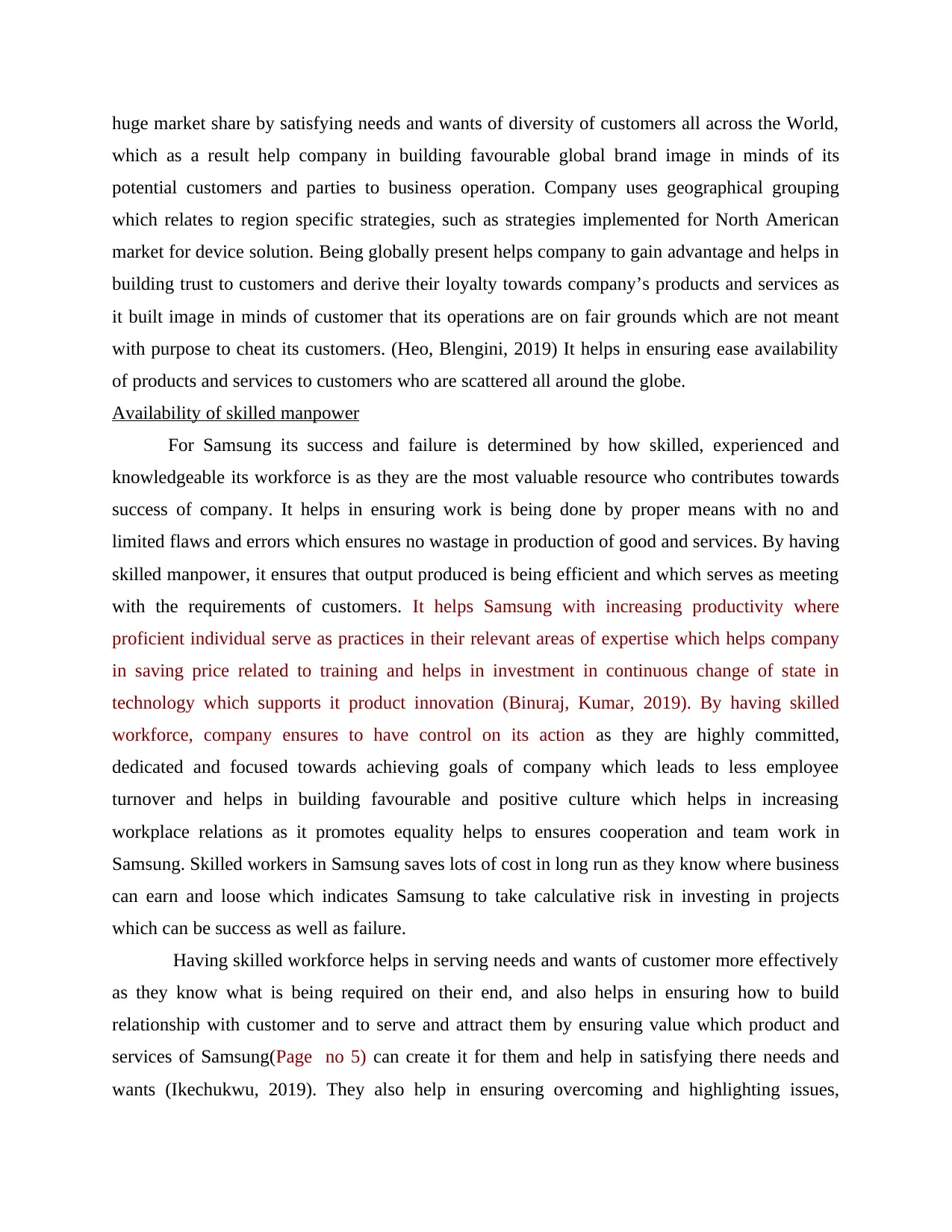
huge market share by satisfying needs and wants of diversity of customers all across the World,
which as a result help company in building favourable global brand image in minds of its
potential customers and parties to business operation. Company uses geographical grouping
which relates to region specific strategies, such as strategies implemented for North American
market for device solution. Being globally present helps company to gain advantage and helps in
building trust to customers and derive their loyalty towards company’s products and services as
it built image in minds of customer that its operations are on fair grounds which are not meant
with purpose to cheat its customers. (Heo, Blengini, 2019) It helps in ensuring ease availability
of products and services to customers who are scattered all around the globe.
Availability of skilled manpower
For Samsung its success and failure is determined by how skilled, experienced and
knowledgeable its workforce is as they are the most valuable resource who contributes towards
success of company. It helps in ensuring work is being done by proper means with no and
limited flaws and errors which ensures no wastage in production of good and services. By having
skilled manpower, it ensures that output produced is being efficient and which serves as meeting
with the requirements of customers. It helps Samsung with increasing productivity where
proficient individual serve as practices in their relevant areas of expertise which helps company
in saving price related to training and helps in investment in continuous change of state in
technology which supports it product innovation (Binuraj, Kumar, 2019). By having skilled
workforce, company ensures to have control on its action as they are highly committed,
dedicated and focused towards achieving goals of company which leads to less employee
turnover and helps in building favourable and positive culture which helps in increasing
workplace relations as it promotes equality helps to ensures cooperation and team work in
Samsung. Skilled workers in Samsung saves lots of cost in long run as they know where business
can earn and loose which indicates Samsung to take calculative risk in investing in projects
which can be success as well as failure.
Having skilled workforce helps in serving needs and wants of customer more effectively
as they know what is being required on their end, and also helps in ensuring how to build
relationship with customer and to serve and attract them by ensuring value which product and
services of Samsung(Page no 5) can create it for them and help in satisfying there needs and
wants (Ikechukwu, 2019). They also help in ensuring overcoming and highlighting issues,
which as a result help company in building favourable global brand image in minds of its
potential customers and parties to business operation. Company uses geographical grouping
which relates to region specific strategies, such as strategies implemented for North American
market for device solution. Being globally present helps company to gain advantage and helps in
building trust to customers and derive their loyalty towards company’s products and services as
it built image in minds of customer that its operations are on fair grounds which are not meant
with purpose to cheat its customers. (Heo, Blengini, 2019) It helps in ensuring ease availability
of products and services to customers who are scattered all around the globe.
Availability of skilled manpower
For Samsung its success and failure is determined by how skilled, experienced and
knowledgeable its workforce is as they are the most valuable resource who contributes towards
success of company. It helps in ensuring work is being done by proper means with no and
limited flaws and errors which ensures no wastage in production of good and services. By having
skilled manpower, it ensures that output produced is being efficient and which serves as meeting
with the requirements of customers. It helps Samsung with increasing productivity where
proficient individual serve as practices in their relevant areas of expertise which helps company
in saving price related to training and helps in investment in continuous change of state in
technology which supports it product innovation (Binuraj, Kumar, 2019). By having skilled
workforce, company ensures to have control on its action as they are highly committed,
dedicated and focused towards achieving goals of company which leads to less employee
turnover and helps in building favourable and positive culture which helps in increasing
workplace relations as it promotes equality helps to ensures cooperation and team work in
Samsung. Skilled workers in Samsung saves lots of cost in long run as they know where business
can earn and loose which indicates Samsung to take calculative risk in investing in projects
which can be success as well as failure.
Having skilled workforce helps in serving needs and wants of customer more effectively
as they know what is being required on their end, and also helps in ensuring how to build
relationship with customer and to serve and attract them by ensuring value which product and
services of Samsung(Page no 5) can create it for them and help in satisfying there needs and
wants (Ikechukwu, 2019). They also help in ensuring overcoming and highlighting issues,
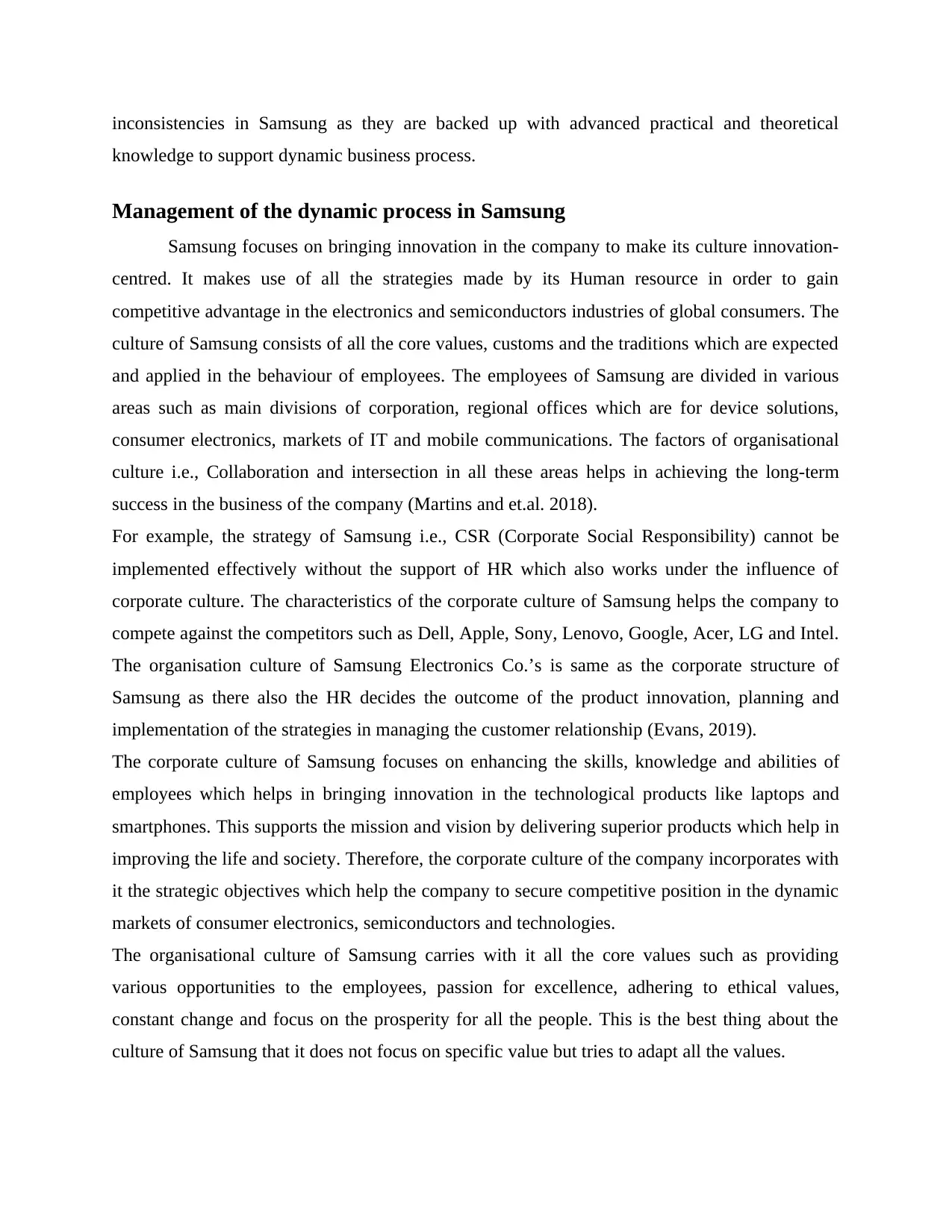
inconsistencies in Samsung as they are backed up with advanced practical and theoretical
knowledge to support dynamic business process.
Management of the dynamic process in Samsung
Samsung focuses on bringing innovation in the company to make its culture innovation-
centred. It makes use of all the strategies made by its Human resource in order to gain
competitive advantage in the electronics and semiconductors industries of global consumers. The
culture of Samsung consists of all the core values, customs and the traditions which are expected
and applied in the behaviour of employees. The employees of Samsung are divided in various
areas such as main divisions of corporation, regional offices which are for device solutions,
consumer electronics, markets of IT and mobile communications. The factors of organisational
culture i.e., Collaboration and intersection in all these areas helps in achieving the long-term
success in the business of the company (Martins and et.al. 2018).
For example, the strategy of Samsung i.e., CSR (Corporate Social Responsibility) cannot be
implemented effectively without the support of HR which also works under the influence of
corporate culture. The characteristics of the corporate culture of Samsung helps the company to
compete against the competitors such as Dell, Apple, Sony, Lenovo, Google, Acer, LG and Intel.
The organisation culture of Samsung Electronics Co.’s is same as the corporate structure of
Samsung as there also the HR decides the outcome of the product innovation, planning and
implementation of the strategies in managing the customer relationship (Evans, 2019).
The corporate culture of Samsung focuses on enhancing the skills, knowledge and abilities of
employees which helps in bringing innovation in the technological products like laptops and
smartphones. This supports the mission and vision by delivering superior products which help in
improving the life and society. Therefore, the corporate culture of the company incorporates with
it the strategic objectives which help the company to secure competitive position in the dynamic
markets of consumer electronics, semiconductors and technologies.
The organisational culture of Samsung carries with it all the core values such as providing
various opportunities to the employees, passion for excellence, adhering to ethical values,
constant change and focus on the prosperity for all the people. This is the best thing about the
culture of Samsung that it does not focus on specific value but tries to adapt all the values.
knowledge to support dynamic business process.
Management of the dynamic process in Samsung
Samsung focuses on bringing innovation in the company to make its culture innovation-
centred. It makes use of all the strategies made by its Human resource in order to gain
competitive advantage in the electronics and semiconductors industries of global consumers. The
culture of Samsung consists of all the core values, customs and the traditions which are expected
and applied in the behaviour of employees. The employees of Samsung are divided in various
areas such as main divisions of corporation, regional offices which are for device solutions,
consumer electronics, markets of IT and mobile communications. The factors of organisational
culture i.e., Collaboration and intersection in all these areas helps in achieving the long-term
success in the business of the company (Martins and et.al. 2018).
For example, the strategy of Samsung i.e., CSR (Corporate Social Responsibility) cannot be
implemented effectively without the support of HR which also works under the influence of
corporate culture. The characteristics of the corporate culture of Samsung helps the company to
compete against the competitors such as Dell, Apple, Sony, Lenovo, Google, Acer, LG and Intel.
The organisation culture of Samsung Electronics Co.’s is same as the corporate structure of
Samsung as there also the HR decides the outcome of the product innovation, planning and
implementation of the strategies in managing the customer relationship (Evans, 2019).
The corporate culture of Samsung focuses on enhancing the skills, knowledge and abilities of
employees which helps in bringing innovation in the technological products like laptops and
smartphones. This supports the mission and vision by delivering superior products which help in
improving the life and society. Therefore, the corporate culture of the company incorporates with
it the strategic objectives which help the company to secure competitive position in the dynamic
markets of consumer electronics, semiconductors and technologies.
The organisational culture of Samsung carries with it all the core values such as providing
various opportunities to the employees, passion for excellence, adhering to ethical values,
constant change and focus on the prosperity for all the people. This is the best thing about the
culture of Samsung that it does not focus on specific value but tries to adapt all the values.
⊘ This is a preview!⊘
Do you want full access?
Subscribe today to unlock all pages.

Trusted by 1+ million students worldwide
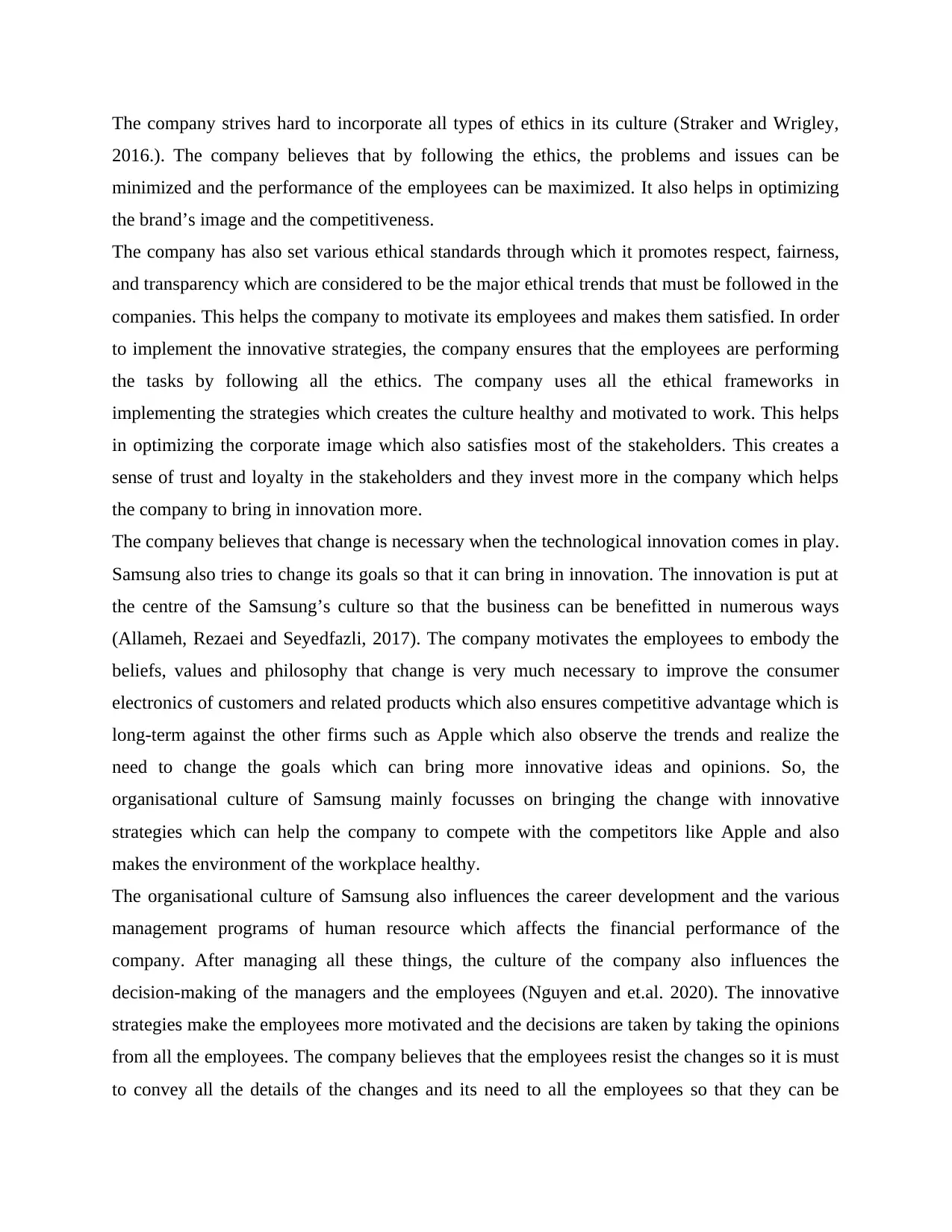
The company strives hard to incorporate all types of ethics in its culture (Straker and Wrigley,
2016.). The company believes that by following the ethics, the problems and issues can be
minimized and the performance of the employees can be maximized. It also helps in optimizing
the brand’s image and the competitiveness.
The company has also set various ethical standards through which it promotes respect, fairness,
and transparency which are considered to be the major ethical trends that must be followed in the
companies. This helps the company to motivate its employees and makes them satisfied. In order
to implement the innovative strategies, the company ensures that the employees are performing
the tasks by following all the ethics. The company uses all the ethical frameworks in
implementing the strategies which creates the culture healthy and motivated to work. This helps
in optimizing the corporate image which also satisfies most of the stakeholders. This creates a
sense of trust and loyalty in the stakeholders and they invest more in the company which helps
the company to bring in innovation more.
The company believes that change is necessary when the technological innovation comes in play.
Samsung also tries to change its goals so that it can bring in innovation. The innovation is put at
the centre of the Samsung’s culture so that the business can be benefitted in numerous ways
(Allameh, Rezaei and Seyedfazli, 2017). The company motivates the employees to embody the
beliefs, values and philosophy that change is very much necessary to improve the consumer
electronics of customers and related products which also ensures competitive advantage which is
long-term against the other firms such as Apple which also observe the trends and realize the
need to change the goals which can bring more innovative ideas and opinions. So, the
organisational culture of Samsung mainly focusses on bringing the change with innovative
strategies which can help the company to compete with the competitors like Apple and also
makes the environment of the workplace healthy.
The organisational culture of Samsung also influences the career development and the various
management programs of human resource which affects the financial performance of the
company. After managing all these things, the culture of the company also influences the
decision-making of the managers and the employees (Nguyen and et.al. 2020). The innovative
strategies make the employees more motivated and the decisions are taken by taking the opinions
from all the employees. The company believes that the employees resist the changes so it is must
to convey all the details of the changes and its need to all the employees so that they can be
2016.). The company believes that by following the ethics, the problems and issues can be
minimized and the performance of the employees can be maximized. It also helps in optimizing
the brand’s image and the competitiveness.
The company has also set various ethical standards through which it promotes respect, fairness,
and transparency which are considered to be the major ethical trends that must be followed in the
companies. This helps the company to motivate its employees and makes them satisfied. In order
to implement the innovative strategies, the company ensures that the employees are performing
the tasks by following all the ethics. The company uses all the ethical frameworks in
implementing the strategies which creates the culture healthy and motivated to work. This helps
in optimizing the corporate image which also satisfies most of the stakeholders. This creates a
sense of trust and loyalty in the stakeholders and they invest more in the company which helps
the company to bring in innovation more.
The company believes that change is necessary when the technological innovation comes in play.
Samsung also tries to change its goals so that it can bring in innovation. The innovation is put at
the centre of the Samsung’s culture so that the business can be benefitted in numerous ways
(Allameh, Rezaei and Seyedfazli, 2017). The company motivates the employees to embody the
beliefs, values and philosophy that change is very much necessary to improve the consumer
electronics of customers and related products which also ensures competitive advantage which is
long-term against the other firms such as Apple which also observe the trends and realize the
need to change the goals which can bring more innovative ideas and opinions. So, the
organisational culture of Samsung mainly focusses on bringing the change with innovative
strategies which can help the company to compete with the competitors like Apple and also
makes the environment of the workplace healthy.
The organisational culture of Samsung also influences the career development and the various
management programs of human resource which affects the financial performance of the
company. After managing all these things, the culture of the company also influences the
decision-making of the managers and the employees (Nguyen and et.al. 2020). The innovative
strategies make the employees more motivated and the decisions are taken by taking the opinions
from all the employees. The company believes that the employees resist the changes so it is must
to convey all the details of the changes and its need to all the employees so that they can be
Paraphrase This Document
Need a fresh take? Get an instant paraphrase of this document with our AI Paraphraser
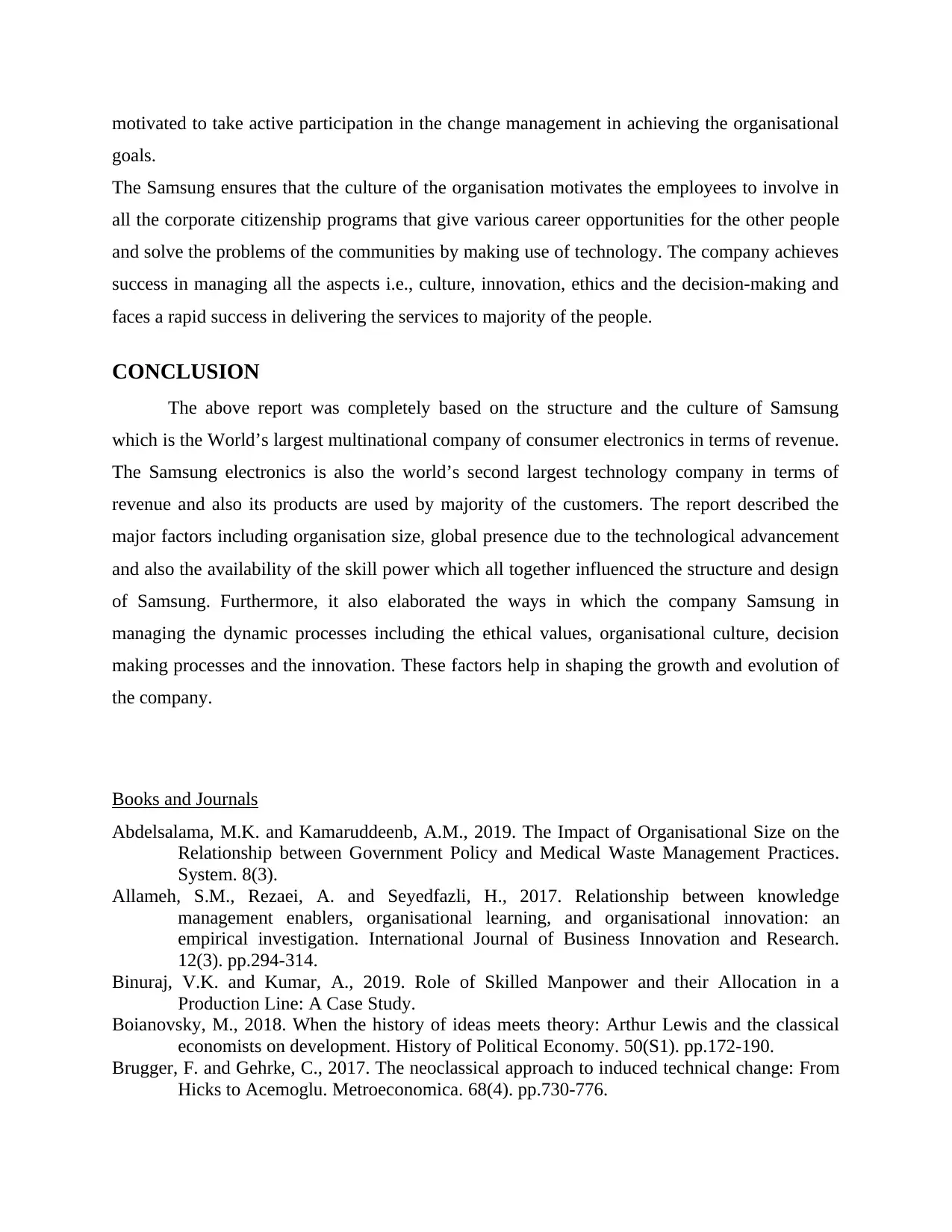
motivated to take active participation in the change management in achieving the organisational
goals.
The Samsung ensures that the culture of the organisation motivates the employees to involve in
all the corporate citizenship programs that give various career opportunities for the other people
and solve the problems of the communities by making use of technology. The company achieves
success in managing all the aspects i.e., culture, innovation, ethics and the decision-making and
faces a rapid success in delivering the services to majority of the people.
CONCLUSION
The above report was completely based on the structure and the culture of Samsung
which is the World’s largest multinational company of consumer electronics in terms of revenue.
The Samsung electronics is also the world’s second largest technology company in terms of
revenue and also its products are used by majority of the customers. The report described the
major factors including organisation size, global presence due to the technological advancement
and also the availability of the skill power which all together influenced the structure and design
of Samsung. Furthermore, it also elaborated the ways in which the company Samsung in
managing the dynamic processes including the ethical values, organisational culture, decision
making processes and the innovation. These factors help in shaping the growth and evolution of
the company.
Books and Journals
Abdelsalama, M.K. and Kamaruddeenb, A.M., 2019. The Impact of Organisational Size on the
Relationship between Government Policy and Medical Waste Management Practices.
System. 8(3).
Allameh, S.M., Rezaei, A. and Seyedfazli, H., 2017. Relationship between knowledge
management enablers, organisational learning, and organisational innovation: an
empirical investigation. International Journal of Business Innovation and Research.
12(3). pp.294-314.
Binuraj, V.K. and Kumar, A., 2019. Role of Skilled Manpower and their Allocation in a
Production Line: A Case Study.
Boianovsky, M., 2018. When the history of ideas meets theory: Arthur Lewis and the classical
economists on development. History of Political Economy. 50(S1). pp.172-190.
Brugger, F. and Gehrke, C., 2017. The neoclassical approach to induced technical change: From
Hicks to Acemoglu. Metroeconomica. 68(4). pp.730-776.
goals.
The Samsung ensures that the culture of the organisation motivates the employees to involve in
all the corporate citizenship programs that give various career opportunities for the other people
and solve the problems of the communities by making use of technology. The company achieves
success in managing all the aspects i.e., culture, innovation, ethics and the decision-making and
faces a rapid success in delivering the services to majority of the people.
CONCLUSION
The above report was completely based on the structure and the culture of Samsung
which is the World’s largest multinational company of consumer electronics in terms of revenue.
The Samsung electronics is also the world’s second largest technology company in terms of
revenue and also its products are used by majority of the customers. The report described the
major factors including organisation size, global presence due to the technological advancement
and also the availability of the skill power which all together influenced the structure and design
of Samsung. Furthermore, it also elaborated the ways in which the company Samsung in
managing the dynamic processes including the ethical values, organisational culture, decision
making processes and the innovation. These factors help in shaping the growth and evolution of
the company.
Books and Journals
Abdelsalama, M.K. and Kamaruddeenb, A.M., 2019. The Impact of Organisational Size on the
Relationship between Government Policy and Medical Waste Management Practices.
System. 8(3).
Allameh, S.M., Rezaei, A. and Seyedfazli, H., 2017. Relationship between knowledge
management enablers, organisational learning, and organisational innovation: an
empirical investigation. International Journal of Business Innovation and Research.
12(3). pp.294-314.
Binuraj, V.K. and Kumar, A., 2019. Role of Skilled Manpower and their Allocation in a
Production Line: A Case Study.
Boianovsky, M., 2018. When the history of ideas meets theory: Arthur Lewis and the classical
economists on development. History of Political Economy. 50(S1). pp.172-190.
Brugger, F. and Gehrke, C., 2017. The neoclassical approach to induced technical change: From
Hicks to Acemoglu. Metroeconomica. 68(4). pp.730-776.
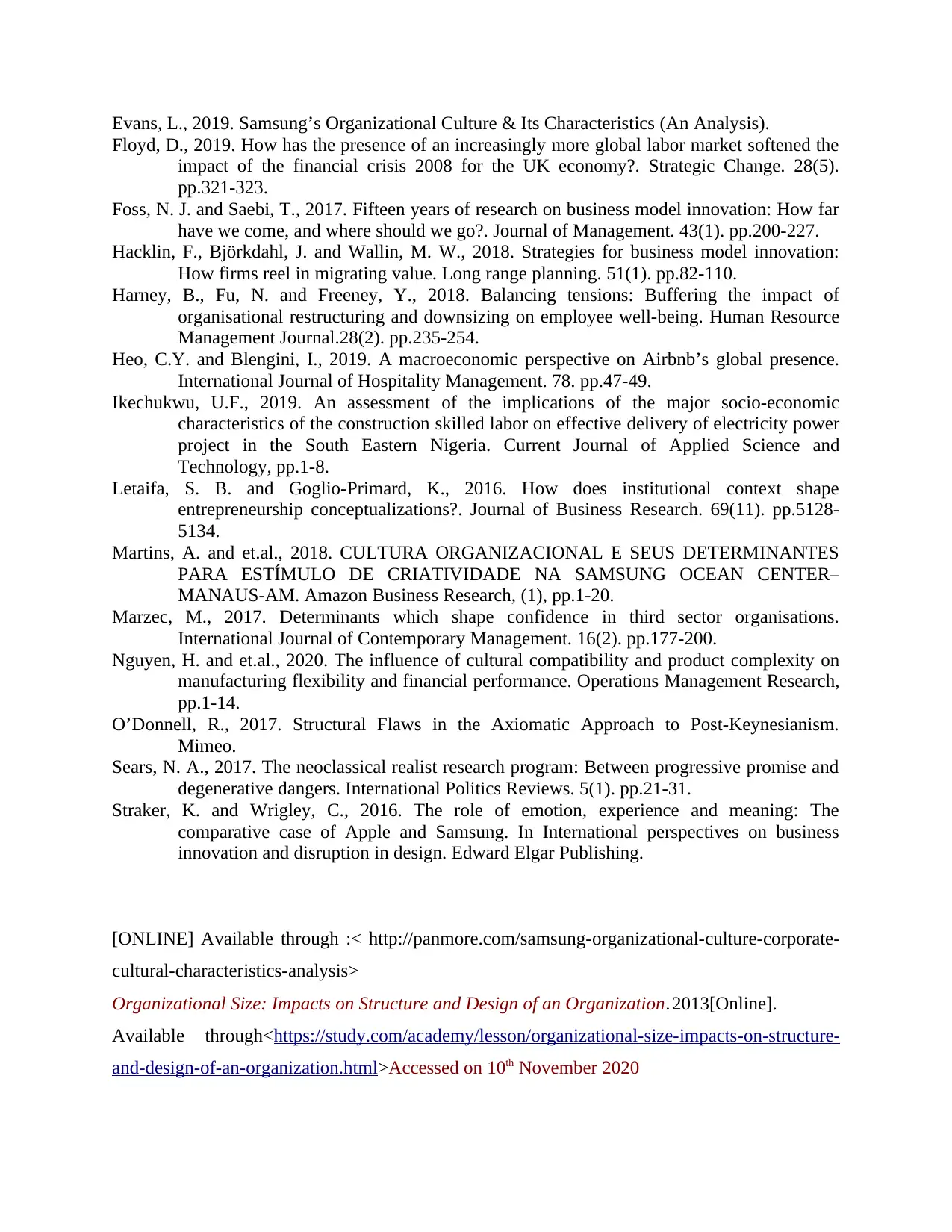
Evans, L., 2019. Samsung’s Organizational Culture & Its Characteristics (An Analysis).
Floyd, D., 2019. How has the presence of an increasingly more global labor market softened the
impact of the financial crisis 2008 for the UK economy?. Strategic Change. 28(5).
pp.321-323.
Foss, N. J. and Saebi, T., 2017. Fifteen years of research on business model innovation: How far
have we come, and where should we go?. Journal of Management. 43(1). pp.200-227.
Hacklin, F., Björkdahl, J. and Wallin, M. W., 2018. Strategies for business model innovation:
How firms reel in migrating value. Long range planning. 51(1). pp.82-110.
Harney, B., Fu, N. and Freeney, Y., 2018. Balancing tensions: Buffering the impact of
organisational restructuring and downsizing on employee well‐being. Human Resource
Management Journal.28(2). pp.235-254.
Heo, C.Y. and Blengini, I., 2019. A macroeconomic perspective on Airbnb’s global presence.
International Journal of Hospitality Management. 78. pp.47-49.
Ikechukwu, U.F., 2019. An assessment of the implications of the major socio-economic
characteristics of the construction skilled labor on effective delivery of electricity power
project in the South Eastern Nigeria. Current Journal of Applied Science and
Technology, pp.1-8.
Letaifa, S. B. and Goglio-Primard, K., 2016. How does institutional context shape
entrepreneurship conceptualizations?. Journal of Business Research. 69(11). pp.5128-
5134.
Martins, A. and et.al., 2018. CULTURA ORGANIZACIONAL E SEUS DETERMINANTES
PARA ESTÍMULO DE CRIATIVIDADE NA SAMSUNG OCEAN CENTER–
MANAUS-AM. Amazon Business Research, (1), pp.1-20.
Marzec, M., 2017. Determinants which shape confidence in third sector organisations.
International Journal of Contemporary Management. 16(2). pp.177-200.
Nguyen, H. and et.al., 2020. The influence of cultural compatibility and product complexity on
manufacturing flexibility and financial performance. Operations Management Research,
pp.1-14.
O’Donnell, R., 2017. Structural Flaws in the Axiomatic Approach to Post-Keynesianism.
Mimeo.
Sears, N. A., 2017. The neoclassical realist research program: Between progressive promise and
degenerative dangers. International Politics Reviews. 5(1). pp.21-31.
Straker, K. and Wrigley, C., 2016. The role of emotion, experience and meaning: The
comparative case of Apple and Samsung. In International perspectives on business
innovation and disruption in design. Edward Elgar Publishing.
[ONLINE] Available through :< http://panmore.com/samsung-organizational-culture-corporate-
cultural-characteristics-analysis>
Organizational Size: Impacts on Structure and Design of an Organization. 2013[Online].
Available through<https://study.com/academy/lesson/organizational-size-impacts-on-structure-
and-design-of-an-organization.html>Accessed on 10th November 2020
Floyd, D., 2019. How has the presence of an increasingly more global labor market softened the
impact of the financial crisis 2008 for the UK economy?. Strategic Change. 28(5).
pp.321-323.
Foss, N. J. and Saebi, T., 2017. Fifteen years of research on business model innovation: How far
have we come, and where should we go?. Journal of Management. 43(1). pp.200-227.
Hacklin, F., Björkdahl, J. and Wallin, M. W., 2018. Strategies for business model innovation:
How firms reel in migrating value. Long range planning. 51(1). pp.82-110.
Harney, B., Fu, N. and Freeney, Y., 2018. Balancing tensions: Buffering the impact of
organisational restructuring and downsizing on employee well‐being. Human Resource
Management Journal.28(2). pp.235-254.
Heo, C.Y. and Blengini, I., 2019. A macroeconomic perspective on Airbnb’s global presence.
International Journal of Hospitality Management. 78. pp.47-49.
Ikechukwu, U.F., 2019. An assessment of the implications of the major socio-economic
characteristics of the construction skilled labor on effective delivery of electricity power
project in the South Eastern Nigeria. Current Journal of Applied Science and
Technology, pp.1-8.
Letaifa, S. B. and Goglio-Primard, K., 2016. How does institutional context shape
entrepreneurship conceptualizations?. Journal of Business Research. 69(11). pp.5128-
5134.
Martins, A. and et.al., 2018. CULTURA ORGANIZACIONAL E SEUS DETERMINANTES
PARA ESTÍMULO DE CRIATIVIDADE NA SAMSUNG OCEAN CENTER–
MANAUS-AM. Amazon Business Research, (1), pp.1-20.
Marzec, M., 2017. Determinants which shape confidence in third sector organisations.
International Journal of Contemporary Management. 16(2). pp.177-200.
Nguyen, H. and et.al., 2020. The influence of cultural compatibility and product complexity on
manufacturing flexibility and financial performance. Operations Management Research,
pp.1-14.
O’Donnell, R., 2017. Structural Flaws in the Axiomatic Approach to Post-Keynesianism.
Mimeo.
Sears, N. A., 2017. The neoclassical realist research program: Between progressive promise and
degenerative dangers. International Politics Reviews. 5(1). pp.21-31.
Straker, K. and Wrigley, C., 2016. The role of emotion, experience and meaning: The
comparative case of Apple and Samsung. In International perspectives on business
innovation and disruption in design. Edward Elgar Publishing.
[ONLINE] Available through :< http://panmore.com/samsung-organizational-culture-corporate-
cultural-characteristics-analysis>
Organizational Size: Impacts on Structure and Design of an Organization. 2013[Online].
Available through<https://study.com/academy/lesson/organizational-size-impacts-on-structure-
and-design-of-an-organization.html>Accessed on 10th November 2020
⊘ This is a preview!⊘
Do you want full access?
Subscribe today to unlock all pages.

Trusted by 1+ million students worldwide

1
1 out of 10
Related Documents
Your All-in-One AI-Powered Toolkit for Academic Success.
+13062052269
info@desklib.com
Available 24*7 on WhatsApp / Email
![[object Object]](/_next/static/media/star-bottom.7253800d.svg)
Unlock your academic potential
Copyright © 2020–2025 A2Z Services. All Rights Reserved. Developed and managed by ZUCOL.





